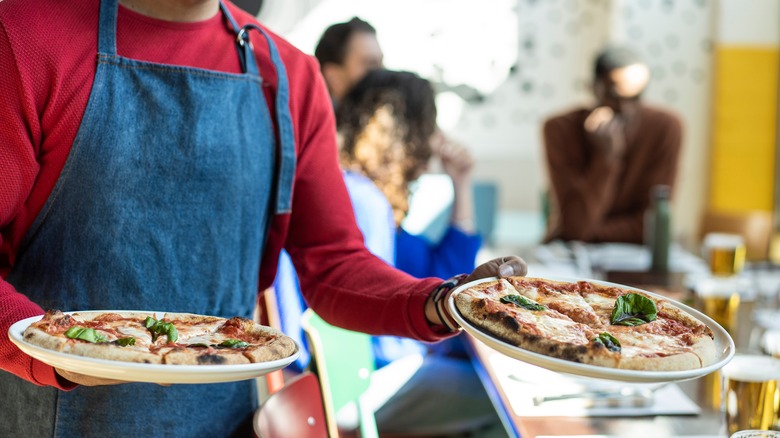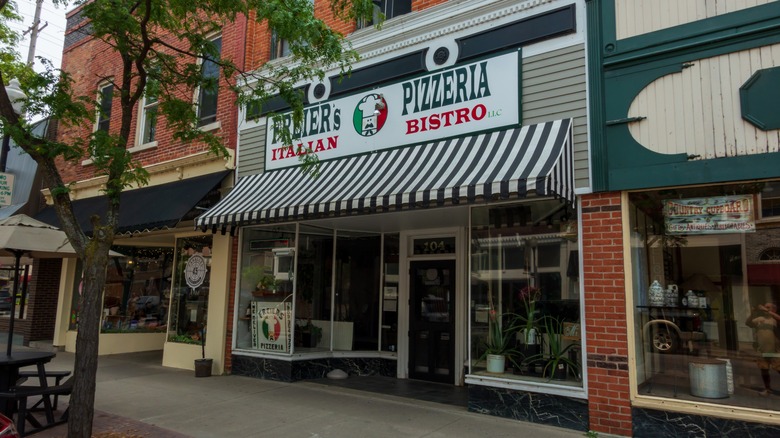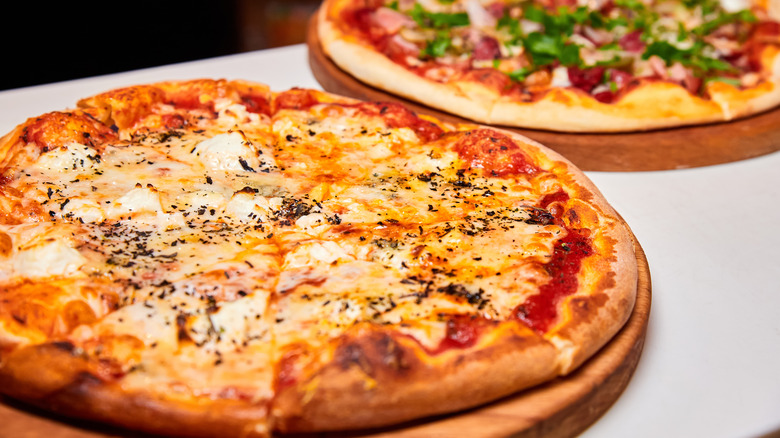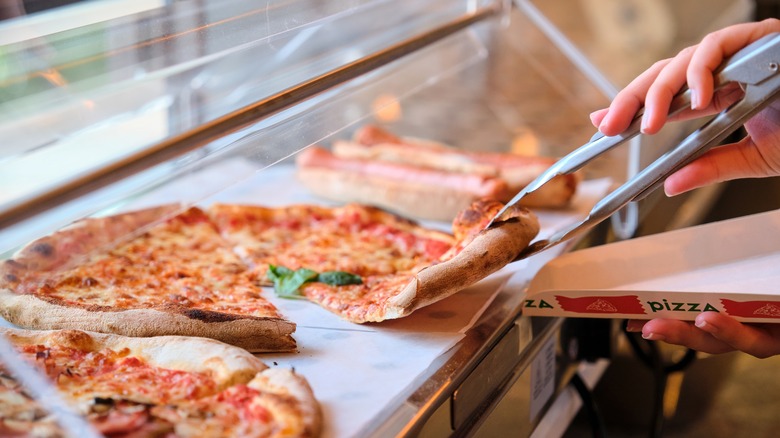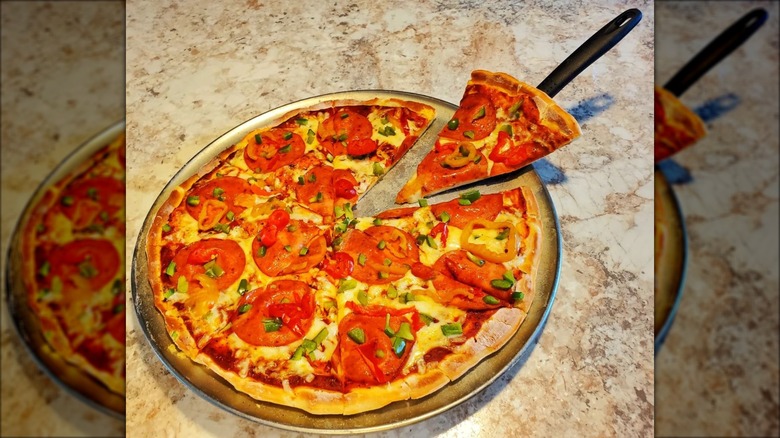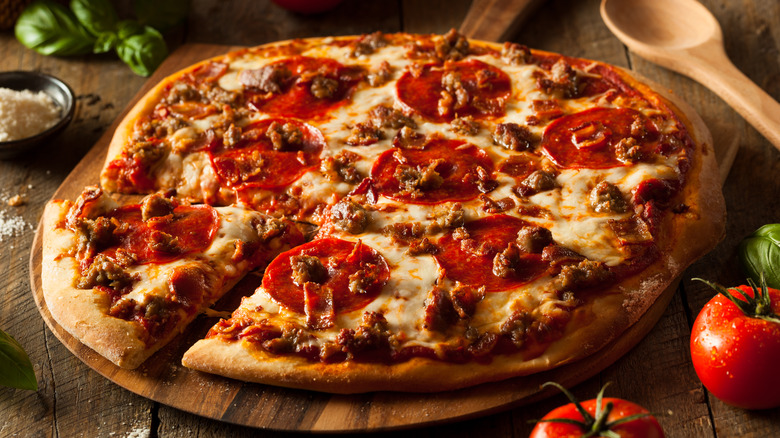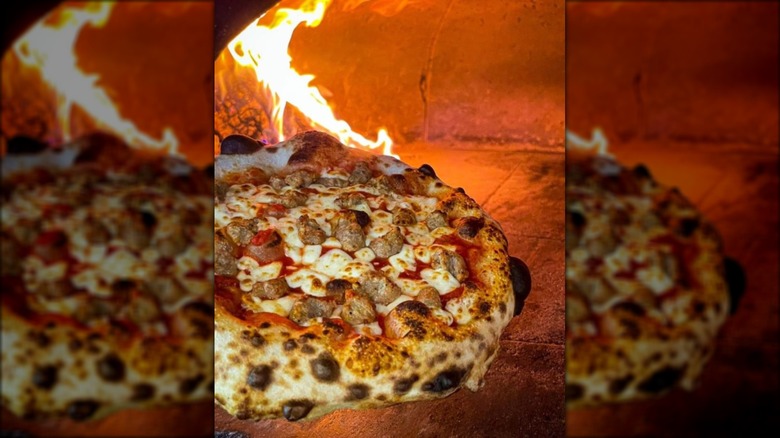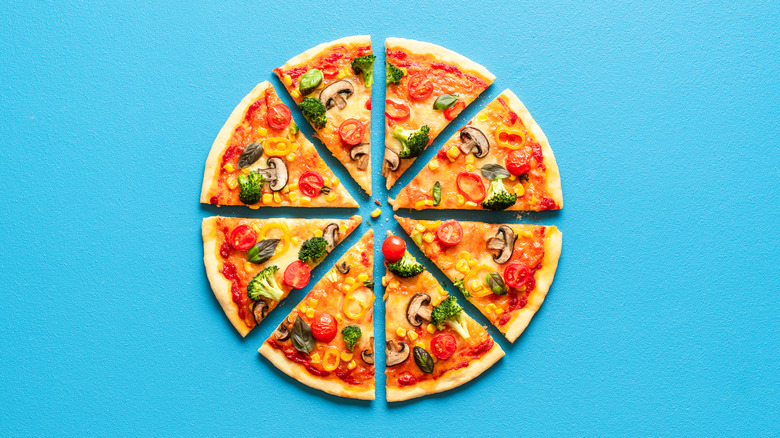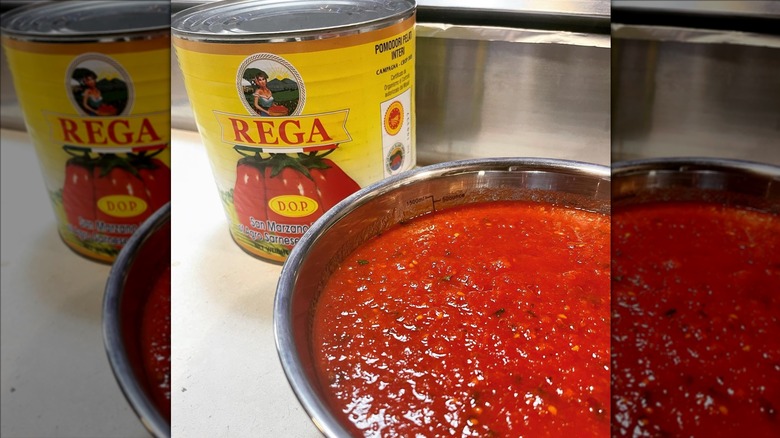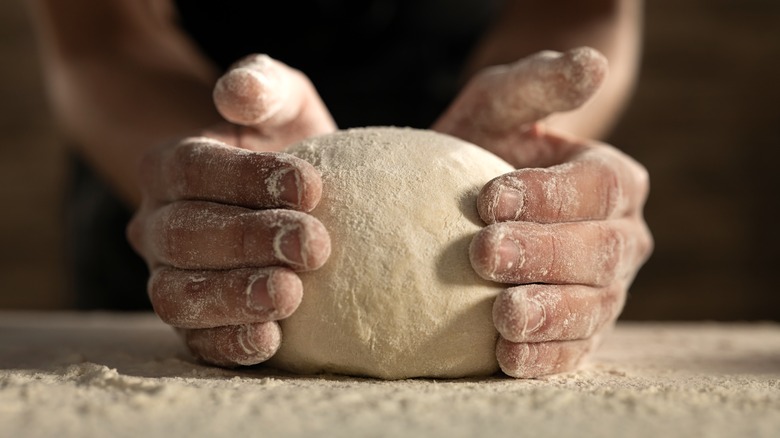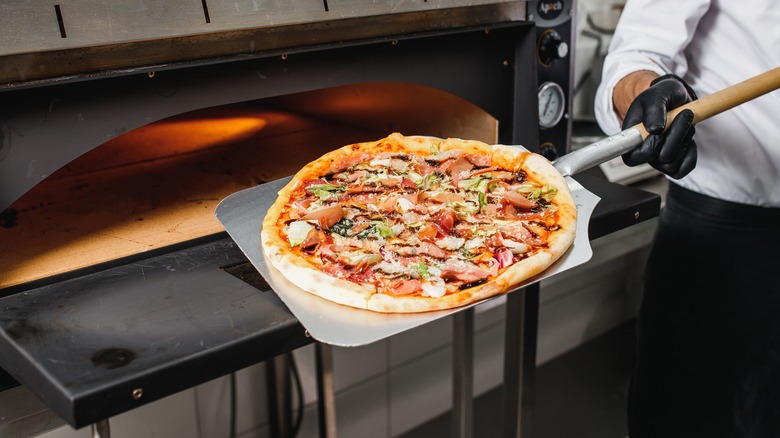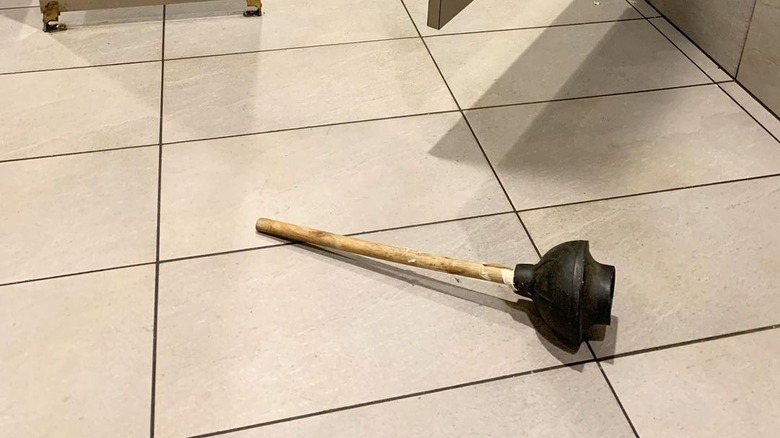12 Red Flags To Look Out For At A Pizza Place
There's an old saying involving pizza and romance that's often attributed to Woody Allen. Pizza deserves the comparison because the saying maintains that, even when it's not so good, it's still pretty darn good.
Although this bit of wisdom is usually intended as a commentary on conjugal relations, it resonates equally well when it comes to pizza. In fact, it may resonate even more when it comes to pizza. It is, after all, a fairly low-stakes proposition with a high level of associated reward.
To wit, pizza is readily obtainable and rather inexpensive just about anywhere and anytime. And unless you're a legit food critic or an actual pizza chef, you might be hard-pressed to recall a single instance in your life when a slice truly disappointed you — as in, spit-take bad. As it turns out, even if you're not all that picky about your pizza, there are still some red flags you'll want to watch out for at pizza places.
1. You actually might be able to judge a pizza place by its cover
They say not the judge a book by its cover, but award-winning pizza chef, 25-year veteran pizza master, and pizzeria owner Glenn Cybulski thinks you can tell a lot about a pizza place by how it presents on the outside. One telltale sign that you may never have even considered (until now) is the ground right outside the front entrance.
"A dark discolored concrete entrance to the pizzeria is a clear sign that cleaning is not taking place properly," Cybulski tells Mashed. And even if it's not actually an issue of cleanliness, it certainly suggests that this particular pizza place is lacking in its attention to detail.
Similarly, as quaint and folksy as a homemade, hand-lettered sign may be, there may still be an issue. When the windows of a pizza place are littered with taped-on "old, dirty, or torn handmade signs," says Cybulski, there may be an underlying message: no one is cleaning those windows. It doesn't take long for food smells and dirt to start permeating the pizza shop and even the pizza itself. Cybulski also notes that those hastily slapped-on signs may also reflect some level of corner-cutting on the part of management.
2. If the pies on display don't look mouth-wateringly delicious, that's a red flag
New York City dwellers may be accustomed to seeing enormous pizza display cases filled with multiple pies just waiting to be sliced and reheated at a moment's notice. But Cybulski tells Mashed that a reputable pizza place will have no more pies in its display case than what it needs to accommodate walk-in customers in search of freshly-made slices.
Food safety expert and instructor at Westchester Community College Elisa Bremner couldn't agree more. Pizzas on display are sitting at what Bremner calls the "temperature danger zone," meaning somewhere between 41 and 135 degrees Fahrenheit. That might be perfectly fine while the pie is fresh out of the oven. But if the slices aren't turning over quickly, you're taking a chance on foodborne illness.
Although you may not know exactly how long the pies have been sitting around, you can tell with just a glance whether the pies look freshly baked. "Pizza should be turning over fast enough that the pies never have a chance to dry out," Cybulski explains. Moreover, the pizza waiting in the display case should look almost as if it could stand to be cooked for a few more minutes. If it's already well-cooked, Cybulski says, "it's going to be cardboard when it's reheated." If the crust is already charred, it's only going to get more so once it's reheated.
3. That display case better be pristine
You never get a second chance to make a first impression, goes yet another old saw, but there's a reason this saying gets repeated so often: it's true. As Cybulski points out to Mashed, "Anything but the most pristine pizza display case is a big red flag [...] A quality pizzeria will be wiping down the glass continuously" while the place is open. Because the pizza display case is getting a lot of handling over the day, lingering fingerprints and smudges simply do not bode well.
On what might seem to be a slightly pickier note, Cybulski also points out that ideally, the pizzas in the display case should be elevated on a pizza stand. A pizza stand keeps crumbs and debris from coming into contact with fresh slices. Elevating the pizzas also makes it easier to clean the display case. And then there's this sobering fact: "If the slice case is littered with crumbs, it is an invitation for rodents and bugs," as Cybulski explains.
4. It's a red flag if your pizza place is overly handsy
Pizza is unabashedly finger food. In other words, if you use a knife and fork, that's just wrong according to a sizeable 15% of respondents to a recent Mashed survey. But we're only talking about eating pizza. If you're the one who happens to be serving up the pie at a pizza place, then tongs are better, unless, of course, you've got gloves on your hands. That's according to Cybulski, who says that seeing a pizzeria employee serving a slice with their bare hands is not merely a red flag, but an "absolute FAIL" that has caused him to turn around and walk straight out of a pizzeria. It's a simple matter of cross-contamination, as whatever is on that employee's hands may be transferred directly to the pizza, and can cause foodborne illness.
Bremner agrees with Cybulski but takes it a step further. "The worst thing [in terms of food safety] is staff using their hands," she tells Mashed. That's true with or without gloves, especially if the person serving the pizza is also handling money. "Paper money has been known to harbor more bacteria than a toilet!" Bremner claims. The same goes if the person has been handling raw food or taken a recent trip to the loo without washing their hands. "Pay attention to whether staff members are washing their hands and changing their gloves between tasks," she advises. If not, consider dining elsewhere.
5. Your pizza place's pepperoni pies offer a unique tell
Most of the pepperoni that's used as a pizza topping is the same kind that you can buy in the supermarket, which is to say, it is of the "no char" and "no curl" variety. Sure, it may curl up some minimal amount at the edges as it cooks, but for the most part, it should lay flat on your pizza, as Cybulski informs Mashed. Accordingly, "if the pepperoni curls up," he says, that's a bad sign.
Moreover, if the pepperoni on your pizza doesn't have an oily sheen to it, that's another red flag. It may well mean that the pepperoni isn't fresh, or that the pepperoni pie has been sitting around for quite some time. In either case, "move on, it's old," as Cybulski advises.
There is one exception to this rule, however, which is what Cybulski refers to as "Cup n Char" pepperoni. "The Cup n Char pepperoni is the exception because it is naturally cased, and when baked, it shrinks," he says. This causes the pepperoni to take on a pronounced cupped shape, which then fills with fresh oil from the pepperoni's fat. It's a beautiful thing, according to Cybulski ... unless, of course, the oil in the cupped pepperoni looks congealed. In that case, it's been sitting out for too long and you're better off skipping that slice.
6. Sausage pizza isn't as easy to get right as you think
Sausage may look tempting on a pizza but tread with caution. That's in part because"Sausage on [pizza] slices has to be cooked well to eliminate any risk of bacterial infection," Cybulski explains. When cooked properly, the sausage should develop a pleasing sheen as the meat's rich fat renders down. If you don't see that sheen, that's a food safety red flag right there, as it may be undercooked
On the other hand, if you see sausage sitting in pools of oil, that means that either the sausage or the pizza has been cooked for too long. That's not so much a food safety issue, though it certainly makes the pizza less appetizing. What else that might say about the food and the care that's put into its preparation is anyone's guess, though it doesn't inspire confidence. So, consider that a red flag as well.
Another sausage-related roadblock for any pizza place is if it uses pre-cooked sausage, according to Cybulski. Pre-cooked sausage is simply not an acceptable ingredient for "any legitimate pizzeria," he maintains.
7. Watch how your pizza place makes veggie pies
Good quality veggie pizza is made to order, according to Cybulski. He notes that if there are veggies already on the pies in the pizza display case, then you can bet those pizzas are dried out and the veggies are likewise less than fresh. "When fresh raw veggies are baked on a pizza, they wick off the moisture," he explains. That means your pizza will come to you "moist and floppy, and when you go to take a bite, it will probably fall apart."
Another veggie pizza-related problem is what Cybulski calls a "sloppy slice." By that, he means one that is overloaded with vegetables. "I look for less veggies because the flavor is still present, and the slice is still crisp." Even better, according to Cybulski, is the sight of sautéed veggies on a freshly baked slice. "Lots of flavor, and almost no soggy crust," he rhapsodizes.
Bremner also has concerns about seeing veggie pies lying around in the pizza display case. "Veggie pizzas tend to be less popular," she notes. That means that, by the time you see them, they've probably been sitting around for too long, especially when it comes to food safety. If the visual of a soggy, bacteria-loaded pizza slice makes you turn around and run, there's always this recipe for 15-minute vegetable pizza you can try for yourself at home.
8. A pizza place's choice of sauce and cheese speak volumes
"The sauce is the boss," quips Cybulski, teasing a potentially catchy catchphrase. And it happens to be one worth your consideration the next time you amble into a pizza place, if only for the simple reason that a truly top-quality pizza shop will use its own sauce recipe. That doesn't mean they're making the sauce from fresh tomatoes, however. Canned tomatoes are actually fine (but if you've seen FX's "The Bear," you probably already know that).
What is not fine is seeing the sauce sitting in an unrefrigerated pan. According to Cybulski, "Even though tomatoes have a high acidity, it only takes a short time once it's warm to start growing bacteria that will make you sick." And that is, of course, a big red flag.
Another problem is the use of pre-shredded mozzarella cheese, which has starch added to it to keep it from clumping. But that starch can also negatively affect the taste of the final pizza. You can also tell a lot about a pizza place just by looking at its parmesan cheese shakers. If you see clumps inside that shaker, it could be a sign that the cheese has been sitting out too long. This can cause it to absorb moisture from the air and make those unsightly clumps. In any case, you're going to get much better results if more flavorful freshly-grated parmesan is available.
9. They don't dough right by their pizza
Got 10 minutes? Then you've got enough time to prep a thin-crust pizza dough using this easy quick thin-crust pizza dough recipe. Accordingly, you might be as surprised as we were to learn that quite a lot of pizzeria operators don't make their own pizza dough. That's not actually a red flag, however, as Cybulski assures Mashed. On the other hand, some still maintain that pre-made pizza dough can never really compare to good freshly-made house dough. It might not be immediately apparent whether any given pizza place is making its own, but signage that says things like "dough made fresh daily" and "our family's recipe" are usually pretty good indicators.
While there's still room for debate in the freshly-crafted or pre-made pizza dough conversation, there is a definite red flag when it comes to pizza dough, according to Cybulski. All dough balls have to proof once they come out of the refrigerator, he explains, meaning they need time to rise as the yeast inside does its thing. But if you see dough balls sitting out in the open with no lid and no wrap of any kind, that's "just not proper baking etiquette" and may expose the dough to dust or germs. More importantly, it's a pretty reliable indicator that the resulting pizza will have a dry, cracked crust.
10. There might be too much on the menu
How many menu items are ideal for any given restaurant? That's going to depend upon the place, but when it comes to pizzerias, less is probably more, according to Cybulski.
He means that in two respects. First, if a particular pizza place's menu offers a wide variety of items in addition to pizza, pasta, and salads, see if you can peek into the kitchen. You might want to consider whether you see anything being made besides pizza, pasta, and salads. If not, then there's a pretty decent chance those other items are coming to the restaurant pre-made and may even be frozen. As an example, Cybulski notes that "Deep fried ravioli is one that almost never tastes good unless they're made in-house." The same is true of pre-manufactured mozzarella sticks.
In addition, Cybulski isn't keen on pizza places that feature foods from a variety of other cultures. "If I see sushi or Indian food on the menu, that is a huge red flag," he explains. "They just cannot execute [a large] menu authentically."
11. Different pizza styles require different kinds of pizza ovens
If you're craving brick oven pizza, Bertucci's is practically always a pretty decent bet. But there are many styles of pizza out there, driven in part by the myriad pizza ovens that are available on the market. If a pizzeria offers various styles because it's making use of more than one kind of pizza oven, that's a "sign of a quality shop," Cybulski informs Mashed. This suggests the owners are not only knowledgeable about the products they're baking but also honest about what they're serving.
On the other hand, if a pizzeria makes use of just a single kind of pizza oven, that's neither here nor there, according to Cybulski. This is especially true in cities like New York, where real estate tends to be small and extremely expensive. The exception, however, is if the menu purports to serve multiple styles, like both brick oven and wood-fired pizza, but there's only one sort of oven. In that case, you've probably encountered a big red flag. "You should be cautious about a shop advertising different styles of pizza while only having one kind of oven," Cybulski advises.
12. Beware the ICK-ICK factor
If you've never heard of the "ICK-ICK" factor, it's probably because we made it up just now to help you remember what may be the single most important red flag of all when it comes to pizza places. The "ICK-ICK" factor is an acronym that also delivers a powerful hit of onomatopoeia. It stands for: "I CAN'T know" what goes on in the non-public areas of a pizzeria, but "I CAN know" what goes on in the public ones. If what you see in a pizza place's public areas looks sketchy, then what does that say about what's happening behind closed doors?
Things to watch out for, according to Cybulski, include chairs that wobble, tables with gum stuck underneath, and visible grease drippings in the kitchen. But nothing should strike you as more disgusting than a less than pristine restroom. The toilets should be sparkling clean, there should be towels to dry one's hands, and trash should be in the trash bin and nowhere else.
"Ask yourself," Cybulski suggests, "if this is what you CAN see, what's happening in the back that you can't?" Indeed.
